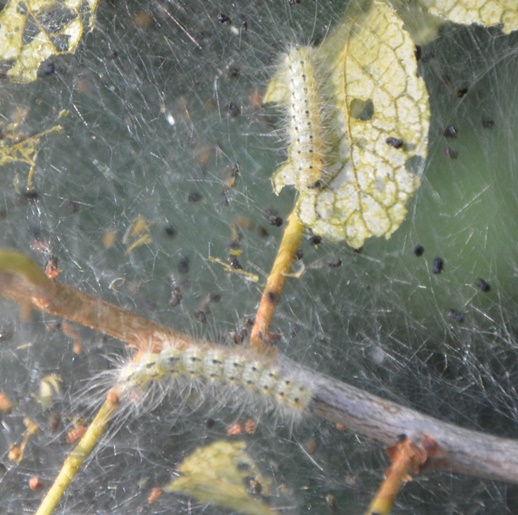
Tent Caterpillars: An Unwelcome Spring Guest
Uninvited guests can sometimes be fun and entertaining, bringing spontaneity to an otherwise predictable schedule. Sometimes the surprise guest is just an unpleasant distraction with no redeeming virtues.
The unanticipated knock on the door can bring both scenarios to mind. Almost everyone has an enjoyable cousin who regales listeners with amusing tales, and picks up the check for dinner.
Likewise, there are those potential callers with parasitic qualities, the appetite of a market hog, and initiative of a sloth. The Eastern Tent Caterpillar is one such visitor in north Florida.
These native caterpillars build large, thick nests on the branch forks and crotches of many kinds of trees, seeming to always choose the prized specimens highly valued by the homeowner. The silky tent shaped nests are easy to see and identity in host trees.
The caterpillars emerging in the spring of 2015 were laid in the spring of 2014. The adult moth lays her eggs in a single batch in May to July in the panhandle. There are 200 to 300 eggs laid in the group.
The mass of eggs are shiny, reddish-brown and look like dried foam. They are ordinarily about six inches back from the tip of a thin twig in host tree.
In approximately three weeks the eggs contain fully formed caterpillars, but the small caterpillars remain in the eggs until the following spring.
In late-February to mid-March they chew their way through their egg shells ready to eat their host tree that is entering the spring budding period with plentiful tender vegetation.
The voracious larvae immediately infest and, if in sufficient numbers, defoliate plum, cherry and many others. Normally the trees recover after a few weeks, but weakened or diseased trees may die.
When not eating, the newly hatched caterpillars construct their silk tent. The caterpillars use a pheromone trail to guild them back home when foraging is done.
A social insect, the eastern tent caterpillars congregate at their specific tent during the night and in rainy weather, expanding it to accommodate their growing size. These caterpillars do not feed within their nests.
The caterpillars disperse to colonize new areas when maturity is reached. They construct cocoons in protected places once they have sufficiently scattered.
Birds are not attracted to these hairy caterpillars. If they have a heavy concentration of black cherry leaves in their diet, the caterpillars will have a bitter acrid taste.
Parasitic wasps and weather are the two most common causes of caterpillar death. These caterpillars are especially susceptible to cold weather once they have emerged from their eggs.
About two weeks later, an adult moth emerges to begin the process again. Mating and egg laying commonly occur within 24 hours of the moths emerging from their cocoons
These brown moths are nocturnal and are seen flying only at night. They are an inch to two inches wingtip to wingtip at maturity and easy to overlook.
Unfortunately, once they arrive for a visit they always overstay their welcome.
Contact your local UF/IFAS County Extension Office to learn more about Eastern Tent Caterpillars in north Florida.
